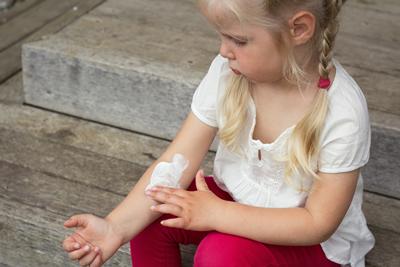New study aims to find the best moisturiser for treating eczema in children

Researchers at the University of Southampton are taking part in a trial to discover which emollient (moisturiser) is the best in treating childhood eczema.
Eczema affects one in five children in the UK and causes dry and itchy skin. The impact on children and their families can be great, commonly interfering with their sleep, play and mood. Most children are looked after by their family doctor (GP) and treated with emollients to relieve skin dryness, and steroid creams (e.g. hydrocortisone) for when the skin gets red and itchy.
The new study, BEE (Best Emollient for Eczema), will compare four of the most commonly used emollients (Aveeno® lotion, Diprobase® cream, Doublebase® gel and Epaderm® ointment) in a randomised clinical trial. This will involve recruiting 520 children through GP surgeries and giving them one of the four emollients to use for at least four months. To assess the long-term effects, there will also a be follow-up after 12 months. Parents and carers of children taking part will be asked to regularly assess and record their child’s eczema symptoms.
The £1.4 million study is being funded by the National Institute for Health Research (NIHR) Health Technology Assessment Programme and also involves the universities of Bristol and Nottingham.
Dr Miriam Santer, Associate Professor in Primary Care Research at the University of Southampton, said: “Emollient moisturisers are the mainstay of eczema treatment and parents are often really surprised that we don’t know which emollient is most effective for childhood eczema. At the moment there is a ‘trial and error’ approach to finding an emollient that works best for their child, which can be frustrating. We are very pleased to be starting the BEE study, as it will address this important evidence gap.”
Dr Matthew Ridd, Consultant Senior Lecturer in Primary Healthcare at the University of Bristol’s Centre for Academic Primary Care and lead researcher on the study, added: “There are many different types and makes of emollient but hardly any research comparing them. As a result, doctors and nurses are unsure which emollient to try first, and prescribing varies from one person to another. This can be confusing and frustrating for families, who often try several emollients before they find one that works for their child.
“Unfortunately, there is no cure for eczema. However, this study should help us find out which of these commonly prescribed emollients is most effective, and which is easiest for children, parents and carers to use. We hope that our results will help shape future national treatment guidelines and reduce the often ‘hit and miss’ nature of prescribing.”
